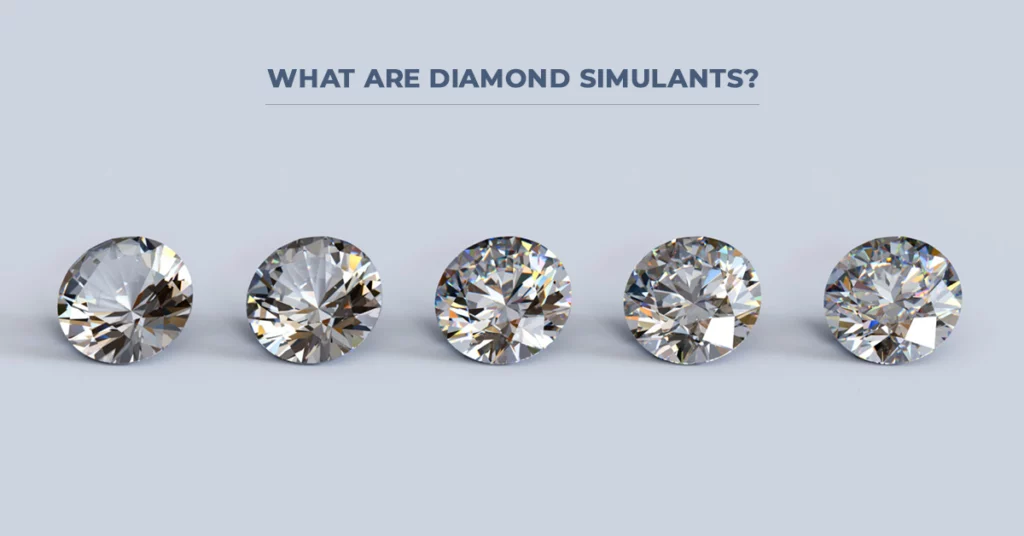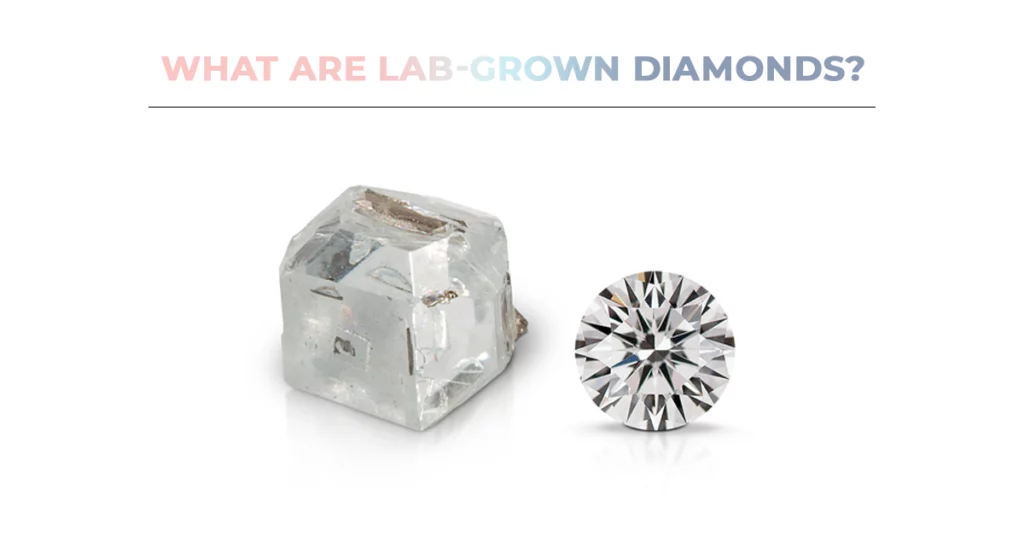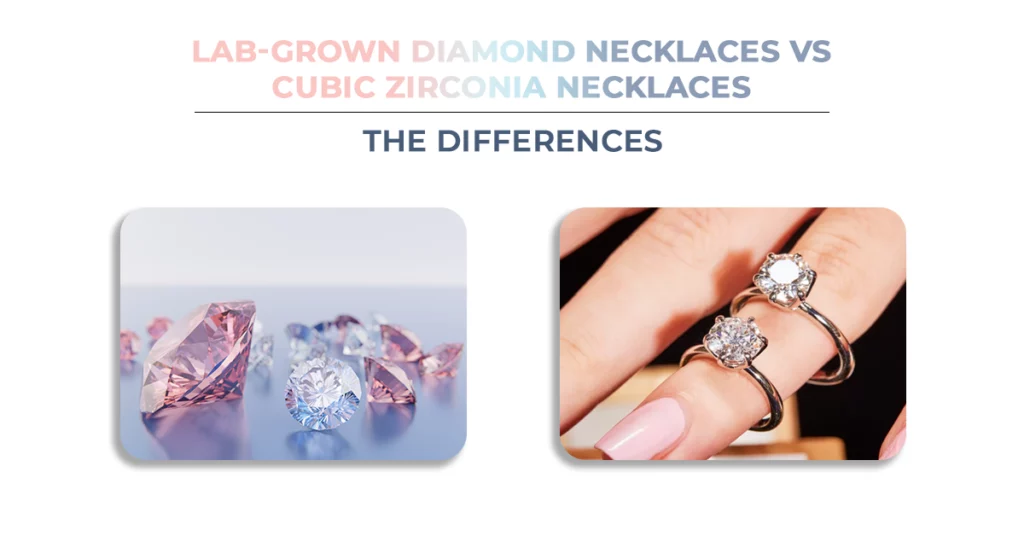
Diamond necklaces, with their radiant allure, have long been at the pinnacle of gemstone jewelry. In 2018, the global diamond jewelry market was valued at around $79 billion. Meanwhile, the worldwide gemstone industry has seen a steady annual growth of 5%. This highlights the immense popularity and demand for diamond jewelry.
Modern technology has also made it possible to manufacture synthetic diamond simulants, like Cubic Zirconia, which are even more affordable. This has led to an increase in the availability and popularity of these alternative gemstones in the market.
So, what are the differences between lab-grown diamond necklaces and those crafted with diamond simulants such as Cubic Zirconia? Let’s find out.

Diamond simulants are materials (synthetic and naturally occurring) that are designed to look like diamonds but aren’t. Cubic Zirconia, Moissanite, and White sapphire are some of the most commonly used stimulants.
They are more affordable but lack the durability and brilliance of diamonds. Necklaces made out of them also do not hold their value over time.
Cubic Zirconia is a synthetic material that is a crystallized form of Zirconium dioxide (ZrO2) and is the most popular diamond alternative today. It is made by heating zirconium dioxide powder to temperatures as high as 2750 °C along with a stabilizer, such as calcium oxide or yttrium oxide.
Once the mixture has turned into a molten mass, it is then allowed to cool down(from top to bottom) to let the crystals form and stabilize. After which, they are cut and polished to look like diamonds.

Lab-grown diamonds, as can be inferred from their name, are synthetic diamonds grown in a lab capable of mimicking the conditions under which natural diamonds are formed. They are exactly the same as naturally formed diamonds in every single aspect.
Two primary processes are used to grow them: High-Pressure High Temperature (HPHT) and Chemical Deposition (CVD both of which can grow diamonds in a matter of weeks as opposed to the millions of years diamonds take to form in nature.

A helpful way to analyze lab diamonds and cubic zirconia is to compare them.
| Parameters | Grown Diamonds | Cubic Zirconia |
| Chemical Composition | Carbon | ZrO2 |
| Hardness | 10 | 8.25 |
| Dispersion | 0.044 | 0.066 |
| Reflexive Index | 2.42 | 2.2 |
| Purity | All production is pure carbon | Contains zero carbon |
| Fossil Fuels Required | Negligible | Negligible |
| Water and Land Use | Negligible | Negligible |
Below are a few points that highlight the fundamental differences between lab-grown diamond necklaces and cubic zirconia necklaces:
Lab-grown diamonds have the same physical and chemical properties as natural diamonds, which means that they have a hardness of 10 on Mohr’s scale. Cubic Zirconia, meanwhile, has a hardness between 8 and 8.5.
Lab-grown diamond necklaces will stand the test of time, whereas necklaces embedded with Cubic Zirconia will tend to pick up scratches over time. Pro Tip: Since Cubic Zirconia is not as durable as diamonds are, the edges of their facets then be rounder as opposed to diamonds that are as sharp as a razor’s edge. So, a quick look with a magnifying glass will be able to tell you if you are looking at a genuine diamond necklace or one made with cubic Zirconia.
Lab-grown diamond necklaces and those made from cubic Zirconia are very similar in appearance, with you giving the two a casual glance. That said, upon closer inspection, there are a few tell-tale signs that can tell you which is what.
Lab-grown diamond necklaces will have that sheer brilliance, i.e., they will reflect an intense white light. Cubic Zirconia, meanwhile, has a lower refractive index than diamonds, which will give out a “rainbow effect” when light passes through it.
Diamonds and Cubic Zirconia are graded on two different color grades, and for good reason.
Diamonds are graded on the Color Scale laid down by the Gemological Insititute of America (GIA), which ranges from D (colorless) to Z (light yellow or brown). The closer a diamond is to the D color grade, the more valuable it is. The reason is that colorless diamonds are a rarity in nature or when grown in a lab.
On the other hand, Cubic Zirconia is graded on the AAA-C scale. The AAA-C color scale is based on the presence of color, meaning that the more colorful a cubic zirconia is, the higher its grade. The scale ranges from AAA to C, with AAA being the highest quality and C being the lowest quality.
Note: The AAA-C color scale is different from the A-AAAAA quality scale, which is used to rate the cut, clarity, and carat of cubic zirconia stones.
Lab-grown diamond necklaces and their cubic zirconia alternatives are readily available globally.
Lab-grown diamond necklaces are more expensive than ones made with cubic Zirconia, but they hold their value much better in the long run.
That said, they still cost much less than those made from natural diamonds and are more ethical and environmentally friendly.
Lab-grown diamond necklaces and cubic zirconia necklaces are both great options in their own right. What is better of the two depends primarily on your desire. If affordability is your deciding parameter, then cubic zirconia necklaces are your best bet.
That said, if you are looking for a necklace that stands the test of time and holds its value better, go for a necklace crafted out of lab-grown diamonds. If you are looking for a stunning and ethical alternative to natural diamonds, browse through La Joya’s extraordinary collection. Whether you are looking for a necklace, a ring, a bracelet, or earrings, you will find something that takes your fancy.
Lab-grown diamond necklaces have several disadvantages over cubic zirconia necklaces. They are more visually appealing than cubic zirconia necklaces. The diamonds have a higher refractive index. They are also more durable and hold their value better.
Cubic Zirconia necklaces are a lot more affordable than their lab-grown alternatives. This means you can have a necklace to match each outfit without leaving a hole in your wallet.
The simplest way to differentiate the two is to point a light source at the gems. If you see a rainbow effect terminating from the gem, you are looking at a necklace made out of cubic Zirconia.
You can also look at the edges of the facets. Lab-grown diamonds have sharp edges, while cubic Zirconia tend to have rounder edges due to their physical properties.
If hit hard enough, it is possible to chip or break a gem made of cubic Zirconia.
Yes, Lab-grown diamond necklaces are ethical as they are grown in a controlled laboratory environment with little to no minimal environmental or social impact.
Although lab grown diamonds and cubic zirconia come in similar shapes, CZs will have inferior refractive qualities compared to lab grown diamonds, which have spectacular shine, fire and sparkle according to a particular cut.
Cubic zirconia is 75% heavier than diamonds. As such, it can be uncomfortably heavy to wear. In contrast, diamonds and other lab grown diamond simulants are lighter. They don’t just look clear and pure; they feel like it, too.
As outlined, we believe that lab-grown diamonds may not be a good financial choice because they may not retain value in the future. We also think they lack the romance and allure of natural diamonds while not necessarily providing any environmental benefits (this is still up for debate).
Cubic Zirconia (CZ) is a man made material and comes from all over the world. There are several methods of making it, and we explained them above. The cubic zirconia (CZ) used for jewelry is a synthetic material.
Shop by metal
Shop by diamond
@ All rights reserved La Joya Jewelry Inc